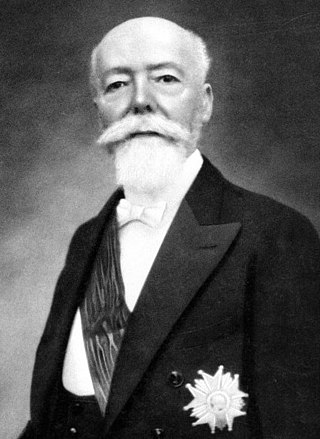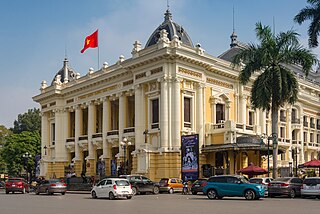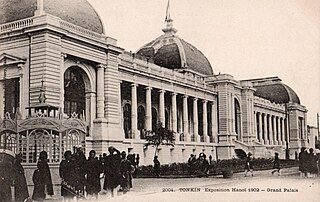
Hanoi is the capital and second-most populous city of Vietnam. As evident by the literal translation of its name – 'inside the river' – portions of Hanoi's border are delineated by the Red and Black Rivers. As a municipality, Hanoi consists of 12 urban districts, 17 rural districts, and one district-level town. It has an area of 3,359.84 km2 (1,297.24 sq mi) and a population of 8,435,700 in 2022. In 2022, Hanoi has the second-highest gross regional domestic product of all Vietnamese provinces and municipalities at 51.4 billion USD, behind Ho Chi Minh City. Hanoi Capital is also ASEAN 8th largest economy after Surabaya.

Joseph Athanase Doumer, commonly known as Paul Doumer, was a French politician who served as the President of France from June 1931 until his assassination in May 1932. He is described as "the Father of French Indochina," and was seen as one of the most active and effective governors general of Indochina.

The Exposition Universelle of 1900, better known in English as the 1900 Paris Exposition, was a world's fair held in Paris, France, from 14 April to 12 November 1900, to celebrate the achievements of the past century and to accelerate development into the next. It was the sixth of ten major expositions held in the city between 1855 and 1937. It was held at the esplanade of Les Invalides, the Champ de Mars, the Trocadéro and at the banks of the Seine between them, with an additional section in the Bois de Vincennes, and it was visited by more than fifty million people. Many international congresses and other events were held within the framework of the exposition, including the 1900 Summer Olympics.

The Trocadéro, site of the Palais de Chaillot, is an area of Paris, France, in the 16th arrondissement, across the Seine from the Eiffel Tower. It is also the name of the 1878 Trocadéro Palace which was demolished in 1937 to make way for the Palais de Chaillot. The hill of the Trocadéro is the hill of Chaillot, a former village.

The Exposition Universelle of 1889, better known in English as the 1889 Paris Exposition, was a world's fair held in Paris, France, from 6 May to 31 October 1889. It was the fifth of ten major expositions held in the city between 1855 and 1937. It attracted more than thirty-two million visitors. The most famous structure created for the exposition, and still remaining, is the Eiffel Tower.

Thành Thái born Nguyễn Phúc Bửu Lân (阮福寶嶙), was the son of Emperor Dục Đức and Empress Dowager Từ Minh. He reigned as emperor for 18 years, from 1889 to 1907. Thành Thái was one of the three "patriotic emperors" in Vietnamese history, along with Hàm Nghi and Duy Tân, for their actions and views against French colonial rule in Vietnam.

The Exposition universelle, internationale et coloniale was a world's fair including a colonial exhibition held at Parc de la Tête d'or in Lyon, France in 1894. The exposition drew unwanted attention with the assassination of French President Sadi Carnot during his visit on 24 June 1894; he died the day after. The exposition drew 3.8 million visitors.
Auguste Henri Vildieu was the French architectural adjutant in Hanoi while that city was an administrative center for the French colony of Indochina. Vildieu constructed several grand European-style buildings for the colonial government, including:

The Hanoi Opera House, or the Grand Opera House is an opera house in central Hanoi, Vietnam. It was erected by the French colonial administration between 1901 and 1911. Hanoi Opera House is one of three opera houses that the French built during their time in Indochina, the others are Haiphong Opera House and Municipal Theatre in Ho Chi Minh city.

Long Biên Bridge is a historic cantilever bridge across the Red River that connects two districts, Hoàn Kiếm and Long Biên of the city of Hanoi, Vietnam. It was originally called Paul Doumer Bridge.

The Imperial Citadel of Thăng Long is a complex of historic buildings associated with the history of Vietnam located in the centre of Hanoi, Vietnam. Its construction began in 1010 and was completed in early 1011 under the reign of Emperor Lý Thái Tổ of the Lý dynasty.

The railway system in Vietnam is owned and operated by the state-owned Vietnam Railways. The principal route, the single track North-South Railway running between Hanoi and Ho Chi Minh City, accounts for 1,726 kilometres (1,072 mi) of the network's total length of 2,600 kilometres (1,600 mi). The national railway network uses mainly metre gauge, although there are several standard gauge and mixed gauge lines in the north of the country.

On December 19, 1946, Viet Minh soldiers detonated explosives in Hanoi, and the ensuing battle, known as the Battle of Hanoi marked the opening salvo of the First Indochina War.

The Brussels International Exposition of 1910 was a world's fair held in Brussels, Belgium, from 23 April to 1 November 1910. This was just thirteen years after Brussels' previous world's fair. It received 13 million visitors, covered 88 hectares and lost 100,000 Belgian francs.

Haiphong Opera House is a French-built neoclassical opera house on Opera Square in Hai Phong, which was opened in 1912.

Tonkin, or Bắc Kỳ, was a French protectorate encompassing modern Northern Vietnam. Like the French protectorate of Annam, Tonkin was still nominally ruled by the Nguyễn dynasty, but in 1886, the French separated Tonkin from the Nguyễn imperial court in Huế by establishing the office of "Viceroy". However, on 26 July 1897, the position of Viceroy was abolished, officially making the French resident-superior of Tonkin both the representative of the French colonial administration and the Nguyễn dynasty court in Huế, giving him the power to appoint local mandarins. In 1887, Tonkin became a part of the Union of Indochina.

The Grand Palais or Grand Palais de l'Exposition was an exhibition and trade fair complex in Hanoi, Vietnam. It was built for the 1902 Hanoi Exhibition world trade fair, as the city became the capital of French Indochina. It was completely destroyed by American airstrikes in World War II.

The Great Hanoi Rat Massacre occurred in 1902, in Hanoi, Tonkin, French Indochina, when the French government authorities attempted to control the rat population of the city by hunting them down. As they felt that they were making insufficient progress, and due to labour strikes, they created a bounty programme that paid a reward of 1¢ for each rat killed. To collect the bounty, people would need to provide the severed tail of a rat. Colonial officials, however, began noticing rats in Hanoi with no tails. The Vietnamese rat catchers would capture rats, sever their tails, then release them back into the sewers so that they could produce more rats.




















